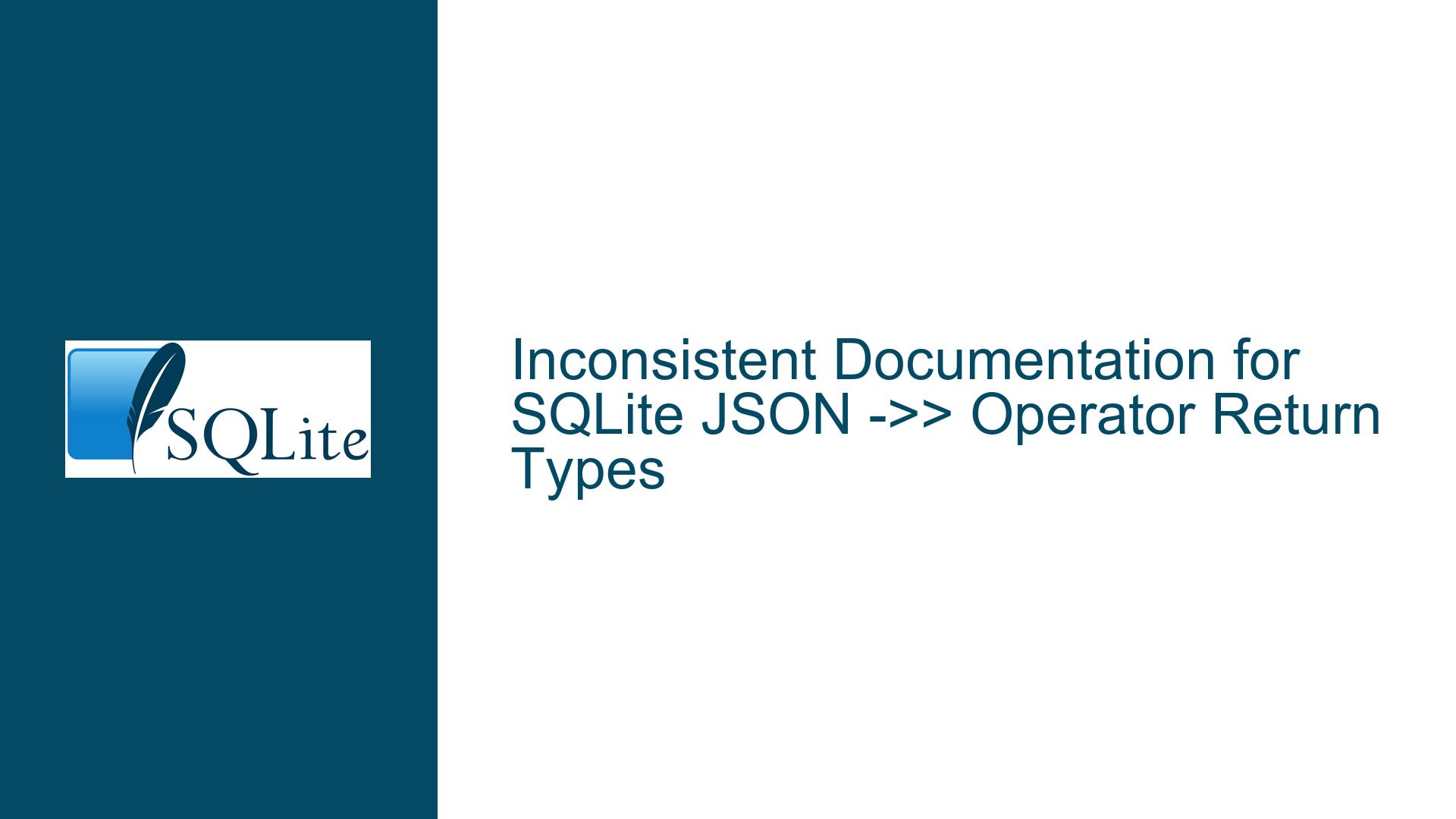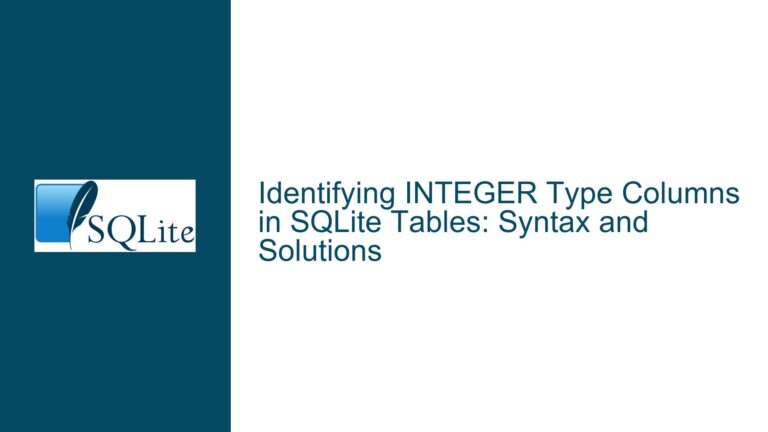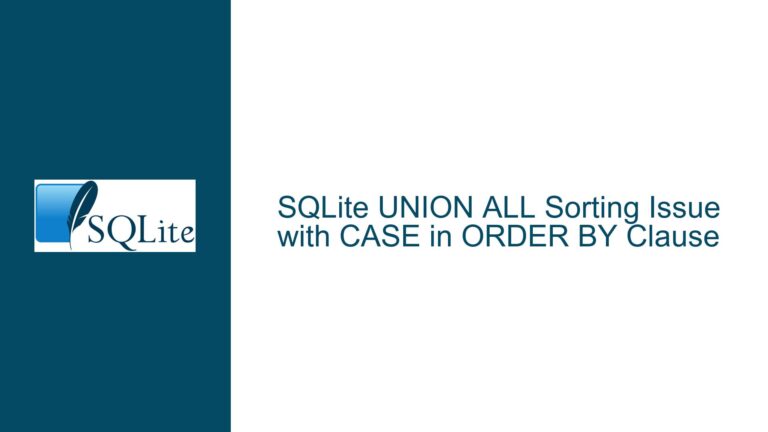Inconsistent Documentation for SQLite JSON ->> Operator Return Types
JSON ->> Operator Return Type Discrepancy in SQLite Documentation
The SQLite documentation presents conflicting information regarding the return types of the JSON ->> operator. This inconsistency can lead to confusion among developers who rely on precise documentation to understand how the operator behaves in different scenarios. The discrepancy primarily revolves around whether the ->> operator returns only text values or can return any SQLite type, including TEXT, INTEGER, REAL, or NULL. This issue is further complicated by the distinction between the -> and ->> operators, which are often used interchangeably but have subtle yet critical differences in their behavior.
The first source of confusion arises from the JSON Functions and Operators section, which states that the ->> operator can return an SQL TEXT, INTEGER, REAL, or NULL value. This suggests that the operator is flexible and can handle various data types depending on the JSON structure being queried. However, the SQL Language Expressions section contradicts this by stating that the -> and ->> operators evaluate to either NULL or a text value. This inconsistency creates ambiguity, especially for developers who need to predict the exact return type of the operator for their specific use case.
The confusion is further exacerbated by the fact that the -> operator is explicitly documented to return only a text JSON representation of the selected subcomponent or NULL if the subcomponent does not exist. This behavior is distinct from the ->> operator, which, according to the JSON Functions and Operators section, can return a broader range of types. The distinction between these two operators is crucial because it directly impacts how developers design their queries and handle the resulting data. Misunderstanding the return types can lead to runtime errors, incorrect data processing, or inefficient query designs.
Ambiguity in Documentation and Its Implications
The ambiguity in the documentation stems from the lack of a unified description of the ->> operator’s behavior across different sections of the SQLite documentation. The JSON Functions and Operators section provides a more comprehensive description, indicating that the ->> operator can return any SQLite type, including TEXT, INTEGER, REAL, or NULL. This aligns with the operator’s intended functionality, which is to extract a value from a JSON object and convert it to the appropriate SQLite type based on its content. For example, if the JSON value is a number, the ->> operator should return an INTEGER or REAL, whereas a string value should return TEXT.
However, the SQL Language Expressions section simplifies this behavior by stating that the ->> operator evaluates to either NULL or a text value. This simplification may have been intended to make the documentation more accessible, but it inadvertently introduces confusion by omitting critical details about the operator’s capabilities. This discrepancy is particularly problematic for developers who rely on the documentation to understand the nuances of SQLite’s JSON support. Without a clear and consistent description, developers may misinterpret the operator’s behavior, leading to suboptimal query designs or unexpected results.
The distinction between the -> and ->> operators is another source of confusion. The -> operator is explicitly documented to return a text JSON representation of the selected subcomponent or NULL if the subcomponent does not exist. This behavior is consistent with its role as a JSON extraction operator that preserves the JSON structure of the extracted value. In contrast, the ->> operator is designed to extract and convert the JSON value to an SQLite type, making it more versatile but also more complex. The documentation’s failure to clearly differentiate between these two operators contributes to the overall confusion and underscores the need for a more consistent and detailed explanation.
Resolving the Inconsistency and Clarifying Operator Behavior
To resolve the inconsistency in the documentation, it is essential to provide a unified and detailed description of the ->> operator’s behavior that accurately reflects its capabilities. The JSON Functions and Operators section should be updated to explicitly state that the ->> operator can return any SQLite type, including TEXT, INTEGER, REAL, or NULL, depending on the JSON value being extracted. This description should be consistent across all relevant sections of the documentation to avoid confusion.
Additionally, the documentation should clearly differentiate between the -> and ->> operators, emphasizing their distinct roles and behaviors. The -> operator should be described as a JSON extraction operator that returns a text JSON representation of the selected subcomponent or NULL if the subcomponent does not exist. In contrast, the ->> operator should be described as a JSON extraction and conversion operator that returns the extracted value as an SQLite type, including TEXT, INTEGER, REAL, or NULL. This distinction is critical for developers to understand how each operator behaves and to choose the appropriate one for their specific use case.
To further clarify the behavior of the ->> operator, the documentation should include examples that demonstrate its ability to return different SQLite types based on the JSON value being extracted. For instance, an example could show how the operator returns an INTEGER when extracting a numeric value, a TEXT when extracting a string, and NULL when extracting a non-existent subcomponent. These examples would help developers visualize the operator’s behavior and reduce the likelihood of misinterpretation.
In conclusion, the inconsistency in the SQLite documentation regarding the return types of the JSON ->> operator creates confusion and can lead to suboptimal query designs. By providing a unified and detailed description of the operator’s behavior, clearly differentiating it from the -> operator, and including illustrative examples, the documentation can be improved to better serve developers and ensure accurate understanding and usage of SQLite’s JSON support.






